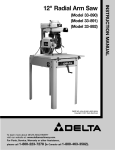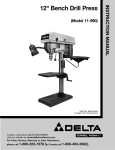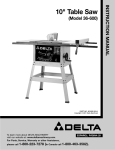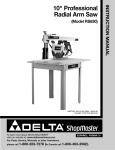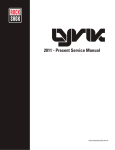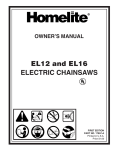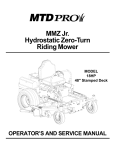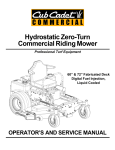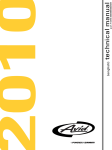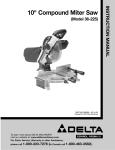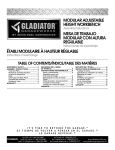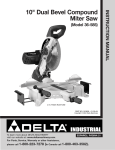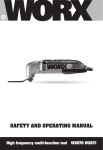Download Delta 33-830 Instruction manual
Transcript
(Model 33-830) PART NO. 424-12-651-0031 (019) Copyright © 2001 Delta Machinery To learn more about DELTA MACHINERY visit our website at: www.deltamachinery.com. For Parts, Service, Warranty or other Assistance, please call ESPAÑOL: PÁGINA 29 1-800-223-7278 (In Canada call 1-800-463-3582). INSTRUCTION MANUAL 10″″ Professional Radial Arm Saw GENERAL SAFETY RULES Woodworking can be dangerous if safe and proper operating procedures are not followed. As with all machinery, there are certain hazards involved with the operation of the product. Using the machine with respect and caution will considerably lessen the possibility of personal injury. However, if normal safety precautions are overlooked or ignored, personal injury to the operator may result. Safety equipment such as guards, push sticks, hold-downs, featherboards, goggles, dust masks and hearing protection can reduce your potential for injury. But even the best guard won’t make up for poor judgment, carelessness or inattention. Always use common sense and exercise caution in the workshop. If a procedure feels dangerous, don’t try it. Figure out an alternative procedure that feels safer. REMEMBER: Your personal safety is your responsibility. This machine was designed for certain applications only. Delta Machinery strongly recommends that this machine not be modified and/or used for any application other than that for which it was designed. If you have any questions relative to a particular application, DO NOT use the machine until you have first contacted Delta to determine if it can or should be performed on the product. Technical Service Manager Delta Machinery 4825 Highway 45 North Jackson, TN 38305 (IN CANADA: 505 SOUTHGATE DRIVE, GUELPH, ONTARIO N1H 6M7) WARNING: FAILURE TO FOLLOW THESE RULES MAY RESULT IN SERIOUS PERSONAL INJURY 1. FOR YOUR OWN SAFETY, READ INSTRUCTION MANUAL BEFORE OPERATING THE TOOL. Learn the tool’s application and limitations as well as the specific hazards peculiar to it. 2. KEEP GUARDS IN PLACE and in working order. 3. ALWAYS WEAR EYE PROTECTION. Wear safety glasses. Everyday eyeglasses only have impact resistant lenses; they are not safety glasses. Also use face or dust mask if cutting operation is dusty. These safety glasses must conform to ANSI Z87.1 requirements. NOTE: Approved glasses have Z87 printed or stamped on them. 4. REMOVE ADJUSTING KEYS AND WRENCHES. Form habit of checking to see that keys and adjusting wrenches are removed from tool before turning it “on”. 5. KEEP WORK AREA CLEAN. Cluttered areas and benches invite accidents. 6. DON’T USE IN DANGEROUS ENVIRONMENT. Don’t use power tools in damp or wet locations, or expose them to rain. Keep work area well-lighted. 7. KEEP CHILDREN AND VISITORS AWAY. All children and visitors should be kept a safe distance from work area. 8. MAKE WORKSHOP CHILDPROOF – with padlocks, master switches, or by removing starter keys. 9. DON’T FORCE TOOL. It will do the job better and be safer at the rate for which it was designed. 10. USE RIGHT TOOL. Don’t force tool or attachment to do a job for which it was not designed. 11. WEAR PROPER APPAREL. No loose clothing, gloves, neckties, rings, bracelets, or other jewelry to get caught in moving parts. Nonslip footwear is recommended. Wear protective hair covering to contain long hair. 12. SECURE WORK. Use clamps or a vise to hold work when practical. It’s safer than using your hand and frees both hands to operate tool. 13. DON’T OVERREACH. Keep proper footing and balance at all times. 14. MAINTAIN TOOLS IN TOP CONDITION. Keep tools sharp and clean for best and safest performance. Follow instructions for lubricating and changing accessories. 15. DISCONNECT TOOLS before servicing and when changing accessories such as blades, bits, cutters, etc. 16. USE RECOMMENDED ACCESSORIES. The use of accessories and attachments not recommended by Delta may cause hazards or risk of injury to persons. 17. REDUCE THE RISK OF UNINTENTIONAL STARTING. Make sure switch is in “OFF” position before plugging in power cord. In the event of a power failure, move switch to the “OFF” position. 18. NEVER STAND ON TOOL. Serious injury could occur if the tool is tipped or if the cutting tool is accidentally contacted. 19. CHECK DAMAGED PARTS. Before further use of the tool, a guard or other part that is damaged should be carefully checked to ensure that it will operate properly and perform its intended function – check for alignment of moving parts, binding of moving parts, breakage of parts, mounting, and any other conditions that may affect its operation. A guard or other part that is damaged should be properly repaired or replaced. 20. DIRECTION OF FEED. Feed work into a blade or cutter against the direction of rotation of the blade or cutter only. 21. NEVER LEAVE TOOL RUNNING UNATTENDED. TURN POWER OFF. Don’t leave tool until it comes to a complete stop. 22. STAY ALERT, WATCH WHAT YOU ARE DOING, AND USE COMMON SENSE WHEN OPERATING A POWER TOOL. DO NOT USE TOOL WHILE TIRED OR UNDER THE INFLUENCE OF DRUGS, ALCOHOL, OR MEDICATION. A moment of inattention while operating power tools may result in serious personal injury. 23. MAKE SURE TOOL IS DISCONNECTED FROM P O W E R S U P P LY w h i l e m o t o r i s b e i n g m o u n t e d , connected or reconnected. 24. THE DUST GENERATED by certain woods and wood products can be injurious to your health. Always operate machinery in well ventilated areas and provide for proper dust removal. Use wood dust collection systems whenever possible. 25. WARNING: SOME DUST CREATED BY POWER SANDING, SAWING, GRINDING, DRILLING, AND OTHER CONSTRUCTION ACTIVITIES contains chemicals known to cause cancer, birth defects or other reproductive harm. Some examples of these chemicals are: · lead from lead-based paints, · crystalline silica from bricks and cement and other masonry products, and · arsenic and chromium from chemically-treated lumber. Your risk from these exposures varies, depending on how often you do this type of work. To reduce your exposure to these chemicals: work in a well ventilated area, and work with approved safety equipment, such as those dust masks that are specially designed to filter out microscopic particles. SAVE THESE INSTRUCTIONS. Refer to them often and use them to instruct others. 2 ADDITIONAL SAFETY RULES FOR RADIAL ARM SAWS 19. NEVER PERFORM a “crossed arm” operation. 20. PROPERLY SUPPORT all long or wide workpieces. 21. NEVER START THE TOOL with the blade engaged in the workpiece. 22. FOLLOW ALL RIPPING WARNINGS on tool. Never rip a workpiece from the wrong end. 23. NEVER FEED WORK into the anti-kickback end of the tool. 24. USE A “PUSH-STICK” for narrow ripping work. 25. REMOVE CUT-OFF PIECES and scraps from the table before cutting. The vibration of the tool may cause them to move into the path of the saw blade and be thrown out. After cutting, and after the blade has come to a complete stop, turn the tool off and remove all debris. 26. TURN THE TOOL “OFF” and disconnect the tool from the power source before adjusting or changing setups. 27. TURN THE TOOL “OFF” and disconnect the tool from the power source when making repairs. 28. TURN THE TOOL “OFF”, disconnect the tool from the power source, and clean the table/work area before leaving the tool. 29. NEVER leave the work area when the power is “ON”, or before the tool has come to a complete stop. 30. IMPORTANT: When the tool is not in use, the switch should be locked in the “OFF” position to prevent unauthorized use. 31. IF ANY PART OF YOUR TOOL IS MISSING, damaged, or fails, or if any electrical component performs improperly, shut off the switch and remove the plug from the power supply. Replace missing, damaged, or failed parts before resuming operation. 1. READ AND UNDERSTAND THE INSTRUCTION MANUAL BEFORE OPERATING THIS TOOL. 2. DO NOT OPERATE THIS TOOL until it is completely assembled and installed according to the instructions. 3. OBTAIN ADVICE from your supervisor, instructor, or some other qualified person if you are not thoroughly familiar with operating this tool. 4. FOLLOW ALL WIRING CODES/recommended electrical connections. PROPERLY GROUND the tool. 5. NEVER USE TOOL WITHOUT GUARDS in place. 6. KEEP BLADE SHARP and free of rust and pitch. 7. KEEP BLADE and arbor flanges free from dirt and grease. 8. SECURELY FASTEN END PLATES TO TRACK ARM prior to use. 9. TIGHTEN ALL CLAMP HANDLES prior to use. 10. WEAR EYE PROTECTION (safety glasses or face shield. 11. DO NOT OPERATE while under the influence of drugs, alcohol, or medication. 12. DO NOT WEAR GLOVES, tie, or loose clothing. REMOVE RINGS, watch, and other jewelry, and roll up sleeves. 13. DO NOT cut any workpiece “freehand”. 14. KNOW HOW TO AVOID KICKBACK. 15. USE ANTI-KICKBACK FINGERS when ripping. Lower the guard on the infeed end and adjust the antikickback attachment properly. 16. USE THE FENCE to support and guide the work. 17. KEEP ARMS AND HANDS OUT OF PATH of the saw blade. 18. NEVER REACH around the saw blade. EXTENSION CORDS Use proper extension cords. Make sure your extension cord is in good condition and is a 3-wire extension cord which has a 3-prong grounding type plug and matching receptacle which will accept the tool’s plug. When using an extension cord, be sure to use one heavy enough to carry the current of the tool. An undersized cord will cause a drop in line voltage, resulting in loss of power and overheating. Fig. A, shows the correct gauge to use depending on the cord length. If in doubt, use the next heavier gauge. The smaller the gauge number, the heavier the cord. MINIMUM GAUGE EXTENSION CORD MINIMUM GAUGE EXTENSION CORD RECOMMENDED SIZES FOR USE WITH STATIONARY ELECTRIC TOOLS RECOMMENDED SIZES FOR USE WITH STATIONARY ELECTRIC TOOLS Ampere Rating Volts Total Length of Cord in Feet Gauge of Extension Cord Ampere Rating Volts Total Length of Cord in Feet Gauge of Extension Cord 0-6 0-6 0-6 0-6 120 120 120 120 up to 25 25-50 50-100 100-150 18 AWG 16 AWG 16 AWG 14 AWG 0-6 0-6 0-6 0-6 240 240 240 240 up to 50 50-100 100-200 200-300 18 AWG 16 AWG 16 AWG 14 AWG 6-10 6-10 6-10 6-10 120 120 120 120 up to 25 25-50 50-100 100-150 18 AWG 16 AWG 14 AWG 12 AWG 6-10 6-10 6-10 6-10 240 240 240 240 up to 50 50-100 100-200 200-300 18 AWG 16 AWG 14 AWG 12 AWG 10-12 10-12 10-12 10-12 120 120 120 120 up to 25 25-50 50-100 100-150 16 AWG 16 AWG 14 AWG 12 AWG 10-12 10-12 10-12 10-12 240 240 240 240 up to 50 50-100 100-200 200-300 16 AWG 16 AWG 14 AWG 12 AWG 12-16 12-16 12-16 120 120 120 up to 25 25-50 14 AWG 12 AWG 12-16 12-16 12-16 240 240 240 up to 50 50-100 14 AWG 12 AWG GREATER THAN 50 FEET NOT RECOMMENDED Fig. A 3 GREATER THAN 100 FEET NOT RECOMMENDED Fig. A POWER CONNECTIONS A separate electrical circuit should be used for your tools. This circuit should not be less than #12 wire and should be protected with a 20 Amp time lag fuse. If an extension cord is used, use only 3-wire extension cords which have 3prong grounding type plugs and matching receptacle which will accept the tool’s plug. Before connecting the motor to the power line, make sure the switch is in the “OFF” position and be sure that the electric current is of the same characteristics as indicated on the tool. All line connections should make good contact. Running on low voltage will damage the motor. WARNING: DO NOT EXPOSE THE TOOL TO RAIN OR OPERATE THE TOOL IN DAMP LOCATIONS. MOTOR SPECIFICATIONS Your tool is wired for 120 volt, 60 HZ alternating current. Before connecting the tool to the power source, make sure the switch is in the “OFF” position. GROUNDING INSTRUCTIONS WARNING: THIS TOOL MUST BE GROUNDED WHILE IN USE TO PROTECT THE OPERATOR FROM ELECTRIC SHOCK. 1. All grounded, cord-connected tools: 2. Grounded, cord-connected tools intended for use on a supply circuit having a nominal rating less than 150 In the event of a malfunction or breakdown, grounding volts: provides a path of least resistance for electric current to reduce the risk of electric shock. This tool is equipped with If the tool is intended for use on a circuit that has an outlet an electric cord having an equipment-grounding that looks like the one illustrated in Fig. B, the tool will have conductor and a grounding plug. The plug must be a grounding plug that looks like the plug illustrated in Fig. plugged into a matching outlet that is properly installed B. A temporary adapter, which looks like the adapter and grounded in accordance with all local codes and illustrated in Fig. C, may be used to connect this plug to a ordinances. matching 2-conductor receptacle as shown in Fig. C if a properly grounded outlet is not available. The temporary Do not modify the plug provided - if it will not fit the outlet, adapter should be used only until a properly grounded have the proper outlet installed by a qualified electrician. outlet can be installed by a qualified electrician. The Improper connection of the equipment-grounding green-colored rigid ear, lug, and the like, extending from conductor can result in risk of electric shock. The the adapter must be connected to a permanent ground conductor with insulation having an outer surface that is such as a properly grounded outlet box. Whenever the green with or without yellow stripes is the equipmentadapter is used, it must be held in place with a metal grounding conductor. If repair or replacement of the screw. electric cord or plug is necessary, do not connect the equipment-grounding conductor to a live terminal. NOTE: In Canada, the use of a temporary adapter is not permitted by the Canadian Electric Code. Check with a qualified electrician or service personnel if the grounding instructions are not completely understood, 3. Grounded, cord-connected tools intended for use on or if in doubt as to whether the tool is properly grounded. a supply circuit having a nominal rating between 150 Use only 3-wire extension cords that have 3-prong 250 volts, inclusive: grounding type plugs and matching 3-conductor receptacles that accept the tool’s plug, as shown in Fig. B. If the tool is intended for use on a circuit that has an Repair or replace damaged or worn cord immediately. outlet that looks like the one illustrated in Fig. D. The tool will have a grounding plug that looks like the plug illustrated in Fig. D. Make sure the tool is connected to an outlet having the same configuration as the plug. No adapter is available or should be used with this tool. If the tool must be re-connected for use on a different type GROUNDED OUTLET BOX of electric circuit, the re-connection should be made by qualified service personnel; and after re-connection, the CURRENT tool should comply with all local codes and ordinances. CARRYING PRONGS WARNING: IN ALL CASES, MAKE CERTAIN THE RECEPTACLE IN QUESTION IS PROPERLY G R O U N D E D . I F Y O U A R E N O T S U R E H AV E A QUALIFIED ELECTRICIAN CHECK THE RECEPTACLE. GROUNDING BLADE IS LONGEST OF THE 3 BLADES Fig. B 4 GROUNDED OUTLET BOX GROUNDED OUTLET BOX CURRENT CARRYING PRONGS GROUNDING MEANS ADAPTER GROUNDING BLADE IS LONGEST OF THE 3 BLADES Fig. C Fig. D CHANGING VOLTAGE The motor supplied with your saw is wired for 120 volt operation. If you desire to operate your saw at 240 volts, it is necessary to reposition voltage changing switch in the motor junction box (B) Fig. E. Proceed as follows: 1. WARNING: DISCONNECT TOOL FROM POWER SOURCE. B 2. Remove screw (A) Fig. E, and remove nameplate cover (B). 3. Carefully slide switch (C) Fig. F, in motor junction box to read 240. Replace nameplate cover and screw which were removed in STEP 2. A Fig. E 4. It is also necessary to replace the 120 volt plug supplied with the motor with a UL/CSA listed plug suitable for 240 volts and the rated current of the saw. Contact your local Authorized Delta Service Center or qualified electrician for proper procedures to install the plug. The saw must comply with all local and national electrical codes after the 240 volt plug is assembled. C Fig. F OVERLOAD PROTECTION D The motor on your saw is equipped with a resettable overload relay button (D) Fig. G. If the motor shuts off or fails to start due to overloading, or low voltage, turn the switch to the “OFF” position, let the motor cool three to five minutes then push the reset button (D). The motor can then be turned on again in the usual manner. Some conditions that may cause overloading are; cutting stock too fast, using a dull blade, using the saw beyond its capacity, etc. 5 Fig. G FUNCTIONAL DESCRIPTION FOREWORD Delta Model 33-830 is a 10" (254mm) Professional Radial Arm Saw with maximum cutting capacity of 16" (406mm) crosscut, 2-3/4" (70mm) depth at 90° and 2-1/2" (64mm) depth at 45° bevel. It is designed with positive bevel stops at 0°, 45° and 90° and positive miter stops at 0° and 45° both right and left. Unit includes; 1-1/2 hp 120/240V motor, automatic blade brake, saw blade, wrenches, steel stand, cast-iron track and extra-large table. UNPACKING AND CLEANING Carefully unpack the tool and all loose items from the shipping container(s). Remove the protective coating from all unpainted surfaces. This coating may be removed with a soft cloth moistened with kerosene (do not use acetone, gasoline or lacquer thinner for this purpose). After cleaning, cover the unpainted surfaces with a good quality household floor paste wax. NOTICE: THE MANUAL COVER PHOTO ILLUSTRATES THE CURRENT PRODUCTION MODEL. ALL OTHER ILLUSTRATIONS ARE REPRESENTATIVE ONLY AND MAY NOT DEPICT THE ACTUAL COLOR, LABELING OR ACCESSORIES. 1. The saw is packed at the factory with support blocks (A) Fig. 1, under the cutter-head (B), and track arm (C). Shipping boards (D) Fig. 1 are fastened to saw base (G). To prevent damage during shipment, the track arm elevating knob (H) is disassembled from lever (E). Before proceeding, insert post of knob (H) Fig. 2, through hole in lever (E) and assemble E-ring (K), to slot in post. C H E B 2. The support blocks (A) Fig. 1, can be removed by rotating track arm elevating knob (H) clockwise and the shipping boards (D) can be removed by removing holddown screws (not shown), which are located inside saw base. Discard the support blocks (A) and shipping boards (D). D G 3 Fig. 3, illustrates the saw with support blocks and shipping boards removed. A Fig. 1 H E K Fig. 2 Fig. 3 6 COMPONENTS OF THE 10" PROFESSIONAL RADIAL ARM SAW ILLUSTRATED IN FIGS. 4 AND 5 1. 10″ Professional Radial Arm Saw 1 2. Left and right table supports 3. 5/16-18 x 5/8″ Carriage Head Screws (16) 4. 5/16″ Flat Washers (16) 7 5. 5/16″ External Tooth Lockwashers (16) 2 6. 5/16″ Hex Nuts (16) 7. Legs (4) 6 4 5 3 Fig. 4 8. Front Table Board 11 10 9. Rear Table Board 10. Middle Table Board 9 11. Fence Board 12. 1/4-20 Flange Nuts (4) 13. 1/4-20 x 1″ Truss Head Screws (4) 8 17 14. Wrenches 15. 1/4-20 x 1-1/4″ Pan Head Screws (4) 20 19 18 16. 5/16-18 x 5/8″ Carriage Head Screws (6) 16 15 12 13 17. 5/16″ Flange Nuts (6) 18. Wrench Hook 14 19. #10 x 1/2″ Screw (2) 20. Table Board Clamp Assembly (2) Fig. 5 7 EXPLANATION OF OPERATING CONTROLS The following is an explanation of the operating controls of the Delta 10" Radial Saw. We suggest you study these explanations carefully to familiarize yourself with the controls before turning on the power. Doing otherwise may cause damage to the saw or personal injury (Figs. 6 and 7). B C K A. TABLE CLAMP KNOBS. Allows the operator to quickly set the desired fence position. Fig. 6 B. TRACK ARM INDEXING RELEASE HANDLE. Releases the indexing pin from the 0 degree and 45 degree positions to allow the arm to rotate. Depress handle to release the index pin. Fig. 6 C. TRACK ARM ELEVATING HANDLE. Controls the depthof-cut in all operations. Turn the handle clockwise to raise or counterclockwise to lower the track arm. Fig. 6 D. MITER SCALE. Indicates degrees left and right for setting track arm to desired miter angle. Fig. 6 F. RIP SCALE. Indicates the in and out rip positions of the cutter-head. Fig. 6 G. BLADE GUARD CLAMP KNOB. Clamps the blade guard at rotated positions for ripping. Fig. 6 H. BEVEL CLAMP HANDLE. Controls tilt of motor for bevel cutting operations. Locks motor at any desired angle on the bevel scale. Lift handle to loosen and push down to lock. Fig. 6 J. BEVEL INDEX RELEASE KNOB. Locates 0 degree, 45 degree, and 90 degree. Positions the motor for bevel setting. When tilting the motor for bevel cutting, the bevel clamp handle must first be loosened. To release the index pull out on the release knob. Fig. 6 K. YOKE INDEXING RELEASE LEVER. Locates each 90 degree position of the yoke for ripping or cross-cutting operations. When rotating the yoke, the yoke clamp handle must first be loose. Push the release lever either up or down to release the indexing pin. Fig. 6 L. YOKE CLAMP HANDLE. The yoke clamp handle must be loose when rotating the yoke between the rip and crosscutting position. Pull the handle to release and push it to lock. Fig. 7 M. ANTI-KICKBACK DEVICE. When ripping, the yoke is positioned and clamped so that the blade is parallel to the fence. The rear of the blade guard is rotated until it almost touches the workpiece. The anti-kickback rod is then lowered so that the fingers catch and hold the workpiece. Never rip from the anti-kickback end of the blade guard. Fig. 7 N. ON-OFF SWITCH. Conveniently located switch can be turned on or off in an instant for added operation protection. Switch also can be locked in the off position to prevent unauthorized use using an accessory padlock. Fig. 7 P. CUTTING-HEAD CLAMP KNOB. Locks cutting-head at any position on the track arm. When ripping the cuttinghead, clamp knob must be tight. Fig. 7 R. BEVEL SCALE. Indicates degrees of rotation for setting motor bevel positions. Fig. 7 S. TRACK ARM CLAMP HANDLE. Controls rotation of track arm for all miter cutting operations. Locks track arm at any miter angle position. To rotate track arm to the right, loosen clamp handle and rotate arm. The arm will stop at 45 degrees. To rotate past 45 degrees, depress indexing release handle and continue to rotate; arm will only rotate an additional 5 degrees. To rotate to the left, the operation is the same except the indexing release handle must be depressed to start rotating. Fig. 7 G D F A J H Fig. 6 P S N L M R Fig. 7 8 ASSEMBLY TOOLS NEEDED FOR ASSEMBLY AND ADJUSTMENT Your Delta Radial Arm Saw can be assembled and adjusted using a few common hand tools, including: • Phillips head screwdriver • Flat blade screwdriver • Framing Square • 7/16″ Wrench • 1/2″ Wrench • 1/2″ Socket, ratchet, and extension • Adj. Combination Square • 3/16″ Allen Wrench • 1/4″ Allen Wrench ASSEMBLING LEGS TO SAW BASE 1. Loosen lock knob (A) Fig. 8, and move cutting-head (B) to the rear position as shown. Then tighten knob (A). 2. IMPORTANT: Make certain the cutting-head is clamped securely at the back of the track arm. A B Fig. 8 3. Place Radial Arm Saw on its back and assemble legs (C) Fig. 9 (three of which are shown assembled) to each corner of saw base (D) using sixteen 5/16-18 x 5/8″ carriage head screws (E), flat washers (G), external tooth lockwashers (H), and hex nuts (J). Place flat washer on bolt. Insert bolt through holes then assemble lockwasher and nut. Hand tighten, hardware at this time but do not completely tighten. Also refer to hardware Fig. 4. C D 4. Stand the saw in the upright position and securely tighten all stand hardware. C H E G Fig. 9 ASSEMBLING WRENCH HOOK TO SAW BASE 1. Assemble wrench hook (K) Fig. 10, to the front right (as shown), or back left, side of saw base (D), using two #10 x 1/2″ shet metal screws. K Fig. 10 9 D J REMOVING BLADE AND BLADE GUARD FROM SAW A 1. DISCONNECT TOOL FROM POWER SOURCE. B 2. Loosen blade guard clamp knob (A) Fig. 11, and rotate blade guard (B) to the position shown. Fig. 11 3. With wrenches supplied (C) Fig. 12, loosen arbor nut (D) as much as possible. NOTE: Arbor nut has left hand threads. B F C D G Fig. 12 4. Lift cam (E) Fig. 13, which holds the blade guard (B) Fig. 12, in position and move the blade guard (B), outer blade flange (F), and blade (G) outward. E Fig. 13 5. Lift blade guard (B) Fig. 14, and remove arbor nut (D), outer blade flange (F), and blade (G). Then remove blade guard (B). B G D F 10 Fig. 14 ASSEMBLING TRACK ARM CLAMP LEVER 1. Assemble track arm clamp lever (A) Fig. 15, by threading into clamp lock nut (B). B A Fig. 15 ASSEMBLING AND ADJUSTING TABLE SUPPORTS B D A 1. Place front table board (A) Fig. 16, on a stable surface with counterbored holes facing down, as shown. C 2. Fasten left and right table supports (B) Fig. 16, to bottom of front table board (A) as shown, by inserting four 1/4-20 x 1″ long truss head screws (C) up through counterbored holes (D) in table board (A) and table supports (B). Secure in place using four flanged hex nuts (E). Do not completely tighten nuts at this time. E D Fig. 16 3. Place front table board (A) Fig. 17, onto saw base (G), so that table supports (B) straddle the outside of saw base (G) and three holes (H) in each table support (B) line up with three slots (J) in each side of saw base (G) as shown. A H B G J Fig. 17 4. Secure table supports, one of which is shown at (B) Fig. 18, to each side of saw base using six 5/16-18 x 5/8″ long carriage head screws (K) and six flanged hex nuts (L). Do not completely tighten nuts at this time. IMPORTANT: Insert screws through saw base table supports from the inside and place flanged nuts on screw on engaged side of base as shown. B L K 11 Fig. 18 5. Using a combination square (M) Figs. 19 and 20, check the left and right front edge of table board (A) to make certain both sides are the same distance from the edge of each table support (B) Fig. 20. M A Fig. 19 A M B 6. When both right and left edges of the table board are the same distance from the table supports, tighten four screws located in holes (N) Fig. 21, of front table board (A). 7. Insert four 1/4″-20 x 1-1/4″ long pan head screws (P) Figs. 21 and 22, into holes (R) Fig. 21, of table board as shown, and tighten each of the screws until each corner of the table board raises approximately 1/8″. Fig. 20 P P N R 8. Loosen bevel clamp lever (S) Fig. 23, pull out bevel index knob (T), and rotate motor (V) to the vertical position as shown, until bevel index engages. Then tighten bevel clamp lever (S). NOTE: If the motor shaft contacts the table board before the motor is fully rotated, raise the track arm (X) Fig. 24, by turning elevating handle (C). N R P N P R N R 9. Loosen cutting-head clamp knob (W) Fig. 23, and move cutting-head to the front of track arm (X). Then tighten cutting-head clamp knob (W). A Fig. 21 W X P V A T P Fig. 22 S 12 Fig. 23 10. Loosen track arm clamp handle (Y) Fig. 24. NOTE: Track clamp handle (Y) has left handed threads. Press down on indexing release handle (Z) and pivot track arm (X) to the left until motor shaft (B) Fig. 25, is near front left adjustment screw (P) of table board (A) as shown. Then tighten track arm clamp handle (Y) Fig. 24. C Z X 11. Place an arbor wrench (D) Fig. 25, between table board (A) and motor shaft (B). Lower track arm (X) Fig. 24, by turning elevating handle (C) counterclockwise until motor shaft (B) Fig. 25, barely touches arbor wrench. Y W Fig. 24 12. Check the height of the table board above the other three table board adjustment screws (E) Fig. 26, by repositioning track arm (X), and cutting-head assembly (V) until the highest point of the table is determined. NOTE: MAKE CERTAIN CUTTING-HEAD CLAMP KNOB (W) FIG. 27 AND TRACK ARM CLAMP HANDLE (Y) ARE TIGHTENED WHEN MOTOR SHAFT IS LOCATED ABOVE EACH OF THE ADJUSTMENT SCREWS. DO NOT CHANGE HEIGHT OF TRACK ARM (X) FIG. 26, UNTIL HIGHEST SCREW IS DETERMINED, AND ALL FOUR CORNERS OF THE TABLE BOARD HAVE BEEN ADJUSTED. B D P 13. Position the motor shaft back over the three lower corners of the table board and adjust the table adjustment screws (E) Fig. 26, until the arbor wrench fits accordingly between the arbor shaft and table board in each location. A Fig. 25 X 14. Once the table board (A) Fig. 28, is properly adjusted, tighten three nuts (G) on each side of saw base (H). Then return track arm (X) and motor (V) to the 90 degree position as shown, and tighten bevel clamp lever (S) and track arm clamp handle (Y) Fig. 27. V E Fig. 26 X Y S H V W G Fig. 27 G Fig. 28 13 A ASSEMBLING TABLE BOARD CLAMPS AND TABLE BOARDS A B 1. Locate table board clamps (A) Fig. 29, and insert one clamp into each of the slotted holes (B) located at the rear of each table support bracket (C) as shown in Fig. 30. C Fig. 29 2. Adjust clamps (A) Fig. 30, so that the clamps are open entirely as shown, by turning knobs (D). A D D A Fig. 30 3. Place 1-1/4″ wide board (E) Fig. 31, against front table board (G), 1-3/4″ wide board (H) in the upright position against 1-1/4″ board, and 5-3/4″ wide board (J) against 1-3/4″ wide board as shown. Then tighten knobs (D), until the table boards are securely clamped in position. G H D ADJUSTING AND CHECKING SAW BLADE TRAVEL SQUARE TO FENCE E D J Fig. 31 B 1. DISCONNECT TOOL FROM POWER SOURCE. A 2. Position rear and middle table boards with 1-3/4″ wide fence board (H) Fig. 32, in the rear position as shown. C 3. Raise track arm (A) Fig. 32, by turning elevating handle (B) until the blade (C) can be assembled on the motor shaft. Then tighten arbor nut (D) using the wrenches supplied. H D 4. Place a framing square (E) Fig. 32, against fence (H) and blade (C) as shown, and lower track arm (A) until the blade just clears the table surface. E 14 Fig. 32 5. Loosen cutting-head clamp knob (S) Fig. 33, and slide cutting-head (T) the entire length of track arm (A) as shown to determine if blade (C) travels parallel to the square (E). A S C T E Fig. 33 6. If an adjustment is necessary, loosen index ring locking screw (J) Fig. 34, and track arm clamp handle (K). 7. Rotate track arm (A) Fig. 33, until blade (C) travels parallel to square (E). Then tighten track arm clamp handle (K) Fig. 34. J K Fig. 34 L 8. With track arm clamp handle (K) Fig. 35, tightened, rotate index ring (L) counterclockwise until it stops. Then tighten index ring locking screw (J) Fig. 36. K 9. There are two miter index pointers, one of which is shown at (M) Fig. 36. Adjust as follows: loosen screw (N) and move pointer (M) until it lines up with the “zero” mark on the miter scale (P). Then tighten screw (N). Adjust the miter index pointer located on the other side of column (R) in the same manner. Fig. 35 J N M P R Fig. 36 15 REMOVING “HEELING” IN SAW BLADE CUT Even though the cutting-head travel may be perfectly aligned at 90 degrees to the fence, the blade itself may not be 90 degrees or square with the fence, as shown in Fig. 37. This condition is known as “heeling.” To check and adjust, proceed as follows: 1. DISCONNECT TOOL FROM POWER SOURCE. 2. Install saw blade without guard. Fig. 37 3. Replace the fence with a flat piece of 3/4″ wood (A) Fig. 38, at least 5″ high. Tighten table board clamps. 4. Place three identical pieces of wood (B) Fig. 38, on the table and lay a framing square on them so that the short arm is flush against the fence and the long arm is against the blade as shown. Be sure square is between the teeth of the blade. A 5. If the blade is not parallel to the square, an adjustment is necessary. Release the yoke clamp handle (C) Fig. 39, and slightly loosen two hex head screws (D). Swivel the yoke until the blade is parallel with the square and tighten yoke clamp handle (C). Then tighten two hex screws (D) Fig. 39. B B Fig. 38 CHECKING AND ADJUSTING SAW BLADE SQUARE TO TABLE C D 1. DISCONNECT TOOL FROM POWER SOURCE. Fig. 39 2. Assemble the inner blade flange, saw blade, outer blade flange, and arbor nut on saw arbor. F 3. Place the cutting-head in a cross-cut position as shown in Fig. 41. Lower track arm until the saw blade is just clear of the table and slide the cutting-head forward until it is positioned over the front table board; clamp the cutting-head in position as shown in Fig. 41. C E 4. Make certain the bevel index knob (A) Fig. 40, is engaged and the motor is in a horizontal position. Tighten bevel clamp handle (C). F B 16 Fig. 40 A 5. Place a square (D) Fig. 41, on the table and against the saw blade, as shown, and check to see if the blade is square with the table. NOTE: The square should rest between two teeth of the saw blade. 6. If an adjustment is necessary, make certain bevel clamp lever (C) Fig. 40, is tight. Remove screw, flat washer, and pointer (E) Fig. 40. Remove two screws (F) Fig. 40, and bevel scale plate (H) Fig. 42, with index knob (A). 7. Loosen four hex head screws (G) Fig. 42. Tilt the motor until the saw blade is flush with the square. Tighten four hex head screws (G). D Fig. 41 8. Replace bevel scale plate (H) Fig. 42, with bevel index release knob (A), two screws, and pointer that were removed in STEP 6. NOTE: Adjust pointer to “zero” on the bevel index scale. A H G Fig. 42 ADJUSTING IN/OUT RIP SCALE 1. DISCONNECT TOOL FROM POWER SOURCE. 2. Loosen yoke clamp handle (A) Fig. 43. Release yoke index by pressing yoke indexing release lever (B) up or down, and rotating cutting-head (C) to the in-rip position as shown. Tighten yoke clamp lever (A). H B K A F C 3. Position fence (D) Fig. 43, at the rear of table as shown. 4. Loosen cutting-head clamp knob (G) Fig. 48 and slide cutting-head (C) Fig. 43, to rear of track arm until saw blade (F) is flush against fence (D). D 5. Tighten cutting-head clamp knob (G) Fig. 48 and adjust pointer (H) Fig. 43, if necessary, to “zero” mark on lower scale (J) by loosening screw (K). After adjustment is made, tighten screw (K). Fig. 43 17 J ASSEMBLING BLADE AND BLADE GUARD TO MACHINE 1. DISCONNECT TOOL FROM POWER SOURCE. USE ONLY 10″″ BLADES WITH 5/8″″ ARBOR HOLES AND RATED FOR 5000 RPM OR HIGHER. A 2. Assemble the inside (thick) arbor flange (A) Fig. 44, onto the arbor shaft with the recessed side of flange (A) facing out. 3. With the blade guard (B) Fig. 45, in the left hand, insert saw blade (C) into the blade guard (B) and onto the arbor shaft. Fig. 44 4. Assemble the outside (thin) blade flange (D) Fig. 45, with the recessed side of flange (D) facing in and arbor nut (E) onto the arbor shaft. NOTE: ARBOR NUT (E) FIG. 45, HAS A LEFT HAND THREAD. B 5. Lift cam (F) Fig. 46, and assemble blade guard (B) onto cutting-head assembly. NOTE: MAKE CERTAIN TONGUE ON GUARD SEATS INTO GROOVE OF CUTTING-HEAD. 6. Rotate blade guard (B) Fig. 47, to the rear and tighten arbor nut (E) using two wrenches (G) supplied. D E 7. Rotate blade guard (B) Fig. 46, to the horizontal position and tighten clamp knob (H). IMPORTANT: CLAMP KNOB (H) FIG. 46, MUST BE TIGHT AND BLADE GUARD SECURE DURING OPERATION. C Fig. 45 H NOTE: The lower retractable blade guard provides operator protection in an axial direction to the saw blade. Care must be taken to eliminate potential hazards of the lower blade guard. B F A) KEEP YOUR HANDS AWAY FROM THE GUARD. As the blade cuts, the guard will lift and leave part of the blade exposed. B) SHUT OFF POWER BEFORE FREEING A JAMMED LOWER GUARD. The guard can get jammed in previous kerfs in table or fence. Always anticipate the path of the guard. Fig. 46 B C) USE CAUTION when making bevel cuts to be sure the lower guard is never pinched towards the blade. D) THE LOWER GUARD CAN JAM AGAINST THE FENCE DURING NARROW IN-RIPS. Should the guard jam against the fence, disconnect the saw from power, wait for the blade to stop, then lift the blade guard and rest it on top of the fence. G E Fig. 47 18 FASTENING SAW TO THE FLOOR If during operation there is any tendency for the saw to tip over, slide, or walk on the supporting surface, the saw should be secured to the floor surface through holes provided on the bottom of each leg. CUTTING INTO TABLE BOARDS G 1. Assemble table boards (A) Fig. 48, and fence (B) as shown and secure in place with table clamps, one of which is shown at (C). B C 2. Return cutting-head (D) Fig. 49, to rear of track arm (E), and tighten cutting-head clamp knob (G) Fig. 48. Make sure switch (H) Fig. 49, is in the “OFF” position and connect saw to power source. A 3. While holding cutting-head handle (L) Fig. 49 firmly, turn switch (H) “ON” and lower track arm (E) by turning elevating handle (K) as shown. Lower saw blade until it cuts into the table surface approximately 1/16″ deep. Then stop turning elevating handle (K). Fig. 48 4. While still holding cutting-head handle (L) Fig. 50 firmly, loosen cutting-head clamp knob (G) Fig. 48, and slowly pull cutting-head (D) Fig. 50, toward the front of the track arm (E) as shown, until travel stops. Then turn switch (H) “OFF”. K E 5. Once saw blade (M) Fig. 51, has come to a complete stop, return cutting-head (D) to rear of track arm (E) as shown. Fig. 51, illustrates saw kerf (N) cut into table boards. D H IMPORTANT: THE TRACK ARM (E) FIG. 51, MUST BE RAISED BEFORE ATTEMPTING TO ROTATE IT. ALSO, THE PROCEDURE “CUTTING INTO TABLE BOARDS” MUST BE PERFORMED FOR EACH ANGLE CUT DESIRED. L Fig. 49 E E D D H M L N Fig. 50 Fig. 51 19 OPERATING CONTROLS AND ADJUSTMENTS ON/OFF SWITCH The on/off switch (A) Fig. 56, is located at the front of the cutting-head. To turn the saw “ON” move the switch (A) Fig. 56, to the up position. To turn the saw “OFF” move the switch (A) Fig. 56, to the down position. IMPORTANT: WHEN THE TOOL IS NOT IN USE, THE SWITCH SHOULD BE LOCKED IN THE “OFF” POSITION TO PREVENT UNAUTHORIZED USE. This can be done by inserting a padlock (D) Fig. 57, through the holes in switch plate (B) and handle (C) as shown. Padlock (D) Fig. 57, is available as an accessory. A Fig. 56 B MOTOR D Your Delta Radial Arm Saw is equipped with a dual voltage motor capable of 120 volt, single phase operation or 240 volt, single phase operation. The motor on your saw is shipped from the factory wired for 120 volt operation. The motor has a built in brake which automatically stops the blade within seconds after turning off the saw or when power is lost. C Fig. 57 B A ADJUSTING BALL BEARINGS AGAINST TRACK C The cutting-head (C) Fig. 61, is suspended from four pre-loaded, lubricated, shielded ball bearings, two of which are on fixed shafts at (A) , and two on adjustable shafts at (B). NOTE: CUTTING-HEAD (C) FIG. 61, IS REMOVED FROM TRACK ARM FOR ILLUSTRATION PURPOSES ONLY. DO NOT REMOVE CUTTING-HEAD FROM TRACK ARM! K B Fig. 61 After extended use, wear may develop in the track arm, causing “play” between the ball bearings and the track. The ball bearings must ride smoothly and evenly in the channels of the track arm. Adjustment to the two bearings on adjustable shafts can be made as follows: D G E 1. DISCONNECT TOOL FROM POWER SOURCE. 2. Remove plastic plug (D) Fig. 62, from the top of track arm (E). Fig. 62 H 3. Slide cutting-head (C) Fig. 63, until one of the adjustable bearings (B) Fig. 60, are visible through hole (G) Figs. 62 and 63. G 4. Using a 1/2″ socket, extension, and ratchet (H) Fig. 63, through hole (G) in track arm, slightly loosen hex nut on adjustable shaft (B) Fig. 61, approximately 1/8 turn. Repeat procedure for other bearing. C 20 Fig. 63 5. Using a 3/16″ Allen wrench (J) Fig. 64, turn adjustment screws (K) Figs. 61 and 64 to remove all “play.” NOTE: DO NOT OVERTIGHTEN ADJUSTMENT SCREWS (K). THIS CAN DAMAGE BEARINGS. K WARNING: DO NOT LOOSEN ADJUSTMENT SCREWS (K) MORE THAN 1/2 TURN. THE CUTTINGHEAD MAY FALL FROM THE TRACK ARM. K J 6. Tighten two hex nuts which were loosened in STEP 4, and check cutting-head travel for any “play” and to ensure it moves freely and smoothly. 7. When adjustments are complete, replace plastic plug which was removed in STEP 2. Fig. 64 ADJUSTING TENSION ON ELEVATING COLUMN Elevating column tension is preset at the factory. It can be adjusted to remove any “play” which may develop after extended use. Adjustments can be made as follows: H F 1. DISCONNECT TOOL FROM POWER SOURCE. C E 2. Loosen hex nuts (A) Fig. 65, and gib adjustment screws (C). D A C B 3. Adjustment to column base (B) Fig. 65, is made by loosening hex nuts (D) and turning screws (E) until column base wraps around column securely and can be raised or lowered without binding. Then tighten hex nuts (D) against column base. 4. After all movement between column base (B) Fig. 65, and elevating column (F) is removed, tighten gib and adjustment screws (C) against gib (H) until all side-toside play is removed. Then tighten hex nuts (A) against column base. NOTE: After adjusting column tension, refer to “ADJUSTING SAW BLADE TRAVEL SQUARE WITH FENCE” to determine if saw blade travel was affected. Fig. 65 CHANGING POSITION OF TRACK ARM CLAMPING HANDLE When the track arm clamping handle (A) Fig. 66, does not lock in a convenient position, it may be repositioned as follows: A 1. DISCONNECT TOOL FROM POWER SOURCE. 2. Loosen and remove track arm clamping lever (A) Fig. 66, and push hex bolt (B) Fig. 67, back through hole until head of bolt is out of the recessed bushing (C) as shown. NOTE: Track arm clamping lever has left hand thread. Fig. 66 21 3. Rotate hex bolt (B) Fig. 67, in the desired direction which the handle needs to be turned. 4. Push hex bolt (B) Fig. 67, back through hole. Make certain head of hex bolt is seated properly in recessed bushing (C), and reassemble track arm clamping lever. NOTE: If track arm clamping lever (A) Fig. 66, tightens before approximately four turns, it is possible the clamping bushings, one of which is shown at (C) Fig. 67, may have rotated. These bushings should be seated completely inside track (D) as shown. If they are not, slightly loosen clamping lever (A) Fig. 66, and rotate clamping bushing (C) Fig. 67, until it seats properly into track (D) as shown. It may be necessary to rotate bushing on clamp lever side also. Fig. 68, illustrates track arm clamping lever assembly unassembled for illustration purposes only. The flats (E) Fig. 68, on clamping bushings (C) should face the front of saw. D B C Fig. 67 NOTE: Clamp lever (A) Fig. 68, will begin to thread at one of two positions. If after making the adjustment the clamp lever (A) tightens 180 degrees from where desired, slowly unscrew clamp lever (A) while holding in on hex bolt (B). When the clamp lever (A) comes off hex bolt (B), rotate clamp lever (A) 180 degrees. Then start to tighten clamp lever (A). E B A C CHANGING POSITION OF BEVEL CLAMP HANDLE When the bevel clamp handle does not lock in a convenient position, it can be repositioned as follows: 1. Fig. 68 DISCONNECT TOOL FROM POWER SOURCE. 2. Loosen bevel clamp handle (A), release bevel index release knob (B), and turn motor (C) to vertical position as shown in Fig. 69. NOTE: IF BLADE GUARD CONTACTS TABLE SURFACE, RAISE TRACK ARM. D B C 3. Loosen bevel clamp handle (A) Fig. 69, several turns, until hex head of screw (D) can be pushed out of hexshaped recess in yoke. A 4. Turn screw (D) Fig. 69, in the desired direction which the handle needs to be turned, one or two flats of the hex head and push it back into hex-shaped recess in yoke. 5. Tighten bevel clamp handle (A) Fig. 69. NOTE: Screw is left hand thread - turn clamp handle counterclockwise to tighten. Fig. 69 CHANGING POSITION OF YOKE CLAMP HANDLE A When the yoke clamp handle (A) Fig. 70, does not lock in a convenient position, it can be repositioned as follows: 1. DISCONNECT TOOL FROM POWER SOURCE. 2 Remove retaining ring (B) Fig. 70. B 3. Reposition yoke clamp handle (A) Fig. 70, on hex clamp nut. 4. Replace retaining ring (B) Fig. 70. Fig. 70 22 POSITIVE STOP YOKE INDEX Yoke index lever (A) Fig. 71, activates a positive stop which positions the cutting-head in the cross-cut or rip position. To rotate the cutting-head, release yoke clamp handle, press up or down on yoke index lever (A), releasing the positive stop, and rotate the cutting-head to the #1 in-rip or #2 out-rip or #3 cross-cut positions as desired. Release the yoke index lever (A) Fig. 71, and the cutting-head will automatically index at each of the three positions above. A Fig. 71 POSITIVE STOP BEVEL INDEX B Bevel index knob (A) Fig. 72, provides a positive stop when positioning the saw blade at zero, 45°, and 90° left, and 90° right on the bevel scale (C). To change the angle of the saw blade, loosen bevel clamp handle (B), pull out bevel index knob (A) and tilt saw blade and motor. For zero, 45°, and 90° left, and 90° right positions, release bevel index knob (A) and saw blade will index at each of these positions. Then tighten bevel clamp handle (B). For saw blade angles between positive stops, set blade at desired angle on bevel scale (C) and tighten bevel clamp handle (B) Fig. 72. A C Fig. 72 ADJUSTING SPLITTER AND ANTI-KICKBACK FINGERS During ripping operations, the splitter (A) Fig. 73, must ride in the saw kerf and the anti-kickback fingers (B) should be touching the workpiece to prevent kickback. 1. Set the saw up in the ripping position with the blade guard lowered on the in-feed side to act as a holddown. 2. Start a piece of material through the saw as shown in Fig. 73. C A 3. Shut off saw and disconnect from power source. B 4. Adjust the arm (C) Fig. 73, so that it is vertical and the splitter (A) is in the saw kerf. 5. If the splitter (A) Fig. 73, does not line up with the saw kerf, loosen hex nuts (D), and position splitter (A) into saw kerf as shown. Then tighten hex nuts (D) against arm (C). The straight side of the splitter should be toward the blade as shown in Fig. 73, and the anti-kickback fingers should rest on the workpiece as shown. NOTE: The clamp knob for arm (C) must be tight. Move arm (C) front to back while tightening clamp knob with other hand to be sure clamp is firmly seated and tight. D Fig. 73 6. Pull backward on the workpiece to determine if the anti-kickback fingers bite into the material and prevent further backward movement. If necessary, readjust height of arm (C) Fig. 73. 23 AUXILIARY TABLE BOARD FACING To prevent repeated cutting into the table surface which will eventually cause the table to sag, an auxiliary table board facing can be cut and fitted to the table. It can be made from 1/4″ plywood or particle board and should be cut to a size that will exactly cover all of the table boards in front of the fence. The auxiliary table board facing should be placed flat on the table and butted against the table fence. Fasten it to the table with a small brad or finish nail in each corner. The life of the table boards will be greatly extended by the use of an auxiliary facing.The auxiliary facing can readily be replaced as often as is necessary to protect the table boards and to insure accurate and safe work. USING A TABLE EXTENSION When a table extension more than 24 inches long is attached to the saw, a sturdy outrigger support should be provided or the stand or bench must be secured to the floor. OPERATIONS CROSS-CUTTING The first operation which should be learned on the radial saw is cross-cutting (Fig. 74). Cross-cutting consists of supporting the workpiece against the fence and pulling the saw blade through the material at right angles to it. When cross-cutting, the track arm should be indexed at “0” and the track arm clamp handle tightened. The fence should be clamped between the table boards. The saw blade is to be to the left and behind the fence. The workpiece is placed on the table and butted against the fence. The saw blade should be clear of the fence and table when the machine is turned on. Then the saw blade is lowered until it lightly cuts into the table surface. The operator should position himself a little to the left of the machine for better visibility while cutting. Pull the saw blade across the work, just far enough to cut it off, and return the saw blade to its starting position. Turn tool off. and wait for the blade to stop before touching the cut-off piece. The operator should always be sure to return the cutter-head carriage to the full rear position after each cross-cut operation. NOTE: When cross-cutting material more than 1″″ thick, the fence must be positioned immediately behind the fixed front table board. Fig. 74 CROSS-CUT STOP A block of wood placed at (B) Fig. 74A clamped to the track arm with a small “C” clamp will prevent unnecessary travel (T) of the cutting-head on the track arm. This is especially useful when performing repetitive operations. Clamp the block of wood to the right side of the track arm at a position which will stop the cuttinghead travel as soon as the saw blade cuts through the workpiece. T B Fig. 74A MITER CUTTING Miter cutting is similar to cross-cutting except the workpiece is cut off at an angle (up to 45 degrees right or left) rather than being cut off square. The settings and operation are performed in the same manner as crosscutting except that the track arm is first positioned to the desired angle on the miter scale before it is clamped in place. The operator should position the hand holding the workpiece on the opposite side to the direction of the miter so the blade is pulled through the workpiece and away from the hand. Fig. 75, shows a typical miter cutting operation on the radial saw. Fig. 75 24 COMPOUND MITER CUTTING Compound miter cutting is performed in the same manner as miter cutting except the saw blade is also tilted to cut a bevel. The settings and operation are similar to miter cutting except that the blade is first tilted to the desired angle on the bevel scale before it is clamped in place. Fig. 76, shows a compound miter cutting operation on the radial saw. Fig. 76 RIPPING IMPORTANT: In certain applications it may be necessary to use two push sticks, and/or featherboards. Also, if a push stick or other feeding device is necessary to assist in the feeding of material, make certain it is conveniently located so it may be reached easily without having to stretch or reach near the blade. A Ripping involves making a lengthwise cut through a board along the grain. When ripping, the track arm is clamped at “0” on the miter scale. The yoke is then positioned and clamped so that the blade is parallel to the fence in either the inboard or outboard position. When feeding the material, one edge rides against the fence while the flat side of the board rests on the table. The guard should be lowered on the in-feed side until it almost touches the workpiece, as shown in Figs. 77 and 78, to act as a holddown. The splitter and anti-kickback fingers (A) Fig. 77, should be adjusted as described under the section “ADJUSTING SPLITTER AND ANTI-KICKBACK FINGERS” in this manual. The operators hands should always be well away from and to the side of the blade. When ripping narrow work, always use a push stick as shown in Fig. 79, to push the work between the fence and blade. The workpiece must have one straight edge to follow the fence. If board is bowed, place hollow side down. The cutting-head clamp knob should be securely tightened for all ripping operations. Pay particular attention to warning label (B) Fig. 78, which states that material must never be fed into the outfeed end of the blade guard. Fig. 77 B Fig. 78 OUT-RIPPING IN-RIPPING Out-ripping involves all of the general conditions stated above. The yoke is clamped at right angle to the track arm with the blade guard facing the front of the machine. The cutting-head is positioned on the out-rip scale to the desired setting and clamped in position. The workpiece is fed from the left side of the saw. Fig. 77, shows a typical out-ripping operation on the radial saw. In-ripping involves all of the general conditions stated under RIPPING. The yoke is clamped at right angle to the track arm with the blade guard facing the rear of the machine. The cutting-head is positioned on the in-rip scale to the desired setting and clamped in position. The workpiece is fed from the right side of the saw. Fig. 78, shows a typical in-ripping operation on the radial saw. WARNING: WHEN RIPPING WORK LESS THAN FOUR INCHES WIDE, A PUSH STICK SHOULD BE USED TO COMPLETE THE FEED (SEE FIG. 79) 25 CONSTRUCTING A PUSH STICK 26 Fig. 79 1/2″ SQUARES CUT OFF HERE TO PUSH 1/2″ WOOD CUT OFF HERE TO PUSH 1/4″ WOOD NOTCH TO HELP PREVENT HAND FROM SLIPPING MAKE FROM 1/2″ OR 3/4″ WOOD OR THICKNESS LESS THAN WIDTH OF MAT’L. TO BE CUT PUSH STICK When ripping work less than 4 inches wide, a push stick should be used to complete the feed and could easily be made from scrap material by following the pattern shown in Fig. 79. ACCESSORIES A complete line of accessories is available from your Delta Supplier, Porter-Cable • Delta Factory Service Centers, and Delta Authorized Service Stations. Please visit our Web Site www.deltamachinery.com for a catalog or for the name of your nearest supplier. WARNING: Since accessories, other than those offered by Delta, have not been tested with this product, use of such accessories could be hazardous. For safest operation, only Delta recommended accessories should be used with this product. PARTS, SERVICE OR WARRANTY ASSISTANCE All Delta Machines and accessories are manufactured to high quality standards and are serviced by a network of Porter-Cable • Delta Factory Service Centers and Delta Authorized Service Stations. To obtain additional information regarding your Delta quality product or to obtain parts, service, warranty assistance, or the location of the nearest service outlet, please call 1-800-223-7278 (In Canada call 1-800-463-3582). Two Year Limited Warranty Delta will repair or replace, at its expense and at its option, any Delta machine, machine part, or machine accessory which in normal use has proven to be defective in workmanship or material, provided that the customer returns the product prepaid to a Delta factory service center or authorized service station with proof of purchase of the product within two years and provides Delta with reasonable opportunity to verify the alleged defect by inspection. Delta may require that electric motors be returned prepaid to a motor manufacturer’s authorized station for inspection and repair or replacement. Delta will not be responsible for any asserted defect which has resulted from normal wear, misuse, abuse or repair or alteration made or specifically authorized by anyone other than an authorized Delta service facility or representative. Under no circumstances will Delta be liable for incidental or consequential damages resulting from defective products. This warranty is Delta’s sole warranty and sets forth the customer’s exclusive remedy, with respect to defective products; all other warranties, express or implied, whether of merchantability, fitness for purpose, or otherwise, are expressly disclaimed by Delta. Printed in U.S.A. 27 NOTES 28 PORTER-CABLE DELTA SERVICE CENTERS (CENTROS DE SERVICIO DE PORTER-CABLE DELTA) Parts and Repair Service for Porter-Cable Delta Power Tools are Available at These Locations (Obtenga Refaccion de Partes o Servicio para su Herramienta en los Siguientes Centros de Porter-Cable ARIZONA Tempe 85282 (Phoenix) 2400 West Southern Avenue Suite 105 Phone: (602) 437-1200 Fax: (602) 437-2200 CALIFORNIA Ontario 91761 (Los Angeles) 3949A East Guasti Road Phone: (909) 390-5555 Fax: (909) 390-5554 San Leandro 94577 (Oakland) 3039 Teagarden Street Phone: (510) 357-9762 Fax: (510) 357-7939 FLORIDA Davie 33314 (Miami) 4343 South State Rd. 7 (441) Unit #107 Phone: (954) 321-6635 Fax: (954) 321-6638 Tampa 33609 4538 W. Kennedy Boulevard Phone: (813) 877-9585 Fax: (813) 289-7948 GEORGIA Forest Park 30297 (Atlanta) 5442 Frontage Road, Suite 112 Phone: (404) 608-0006 Fax: (404) 608-1123 ILLINOIS Addison 60101 (Chicago) 311 Laura Drive Phone: (630) 628-6100 Fax: (630) 628-0023 Woodridge 60517 (Chicago) 2033 West 75th Street Phone: (630) 910-9200 Fax: (630) 910-0360 MARYLAND Elkridge 21075 (Baltimore) 7397-102 Washington Blvd. Phone: (410) 799-9394 Fax: (410) 799-9398 MASSACHUSETTS Braintree 02185 (Boston) 719 Granite Street Phone: (781) 848-9810 Fax: (781) 848-6759 Franklin 02038 (Boston) Franklin Industrial Park 101E Constitution Blvd. Phone: (508) 520-8802 Fax: (508) 528-8089 MICHIGAN Madison Heights 48071 (Detroit) 30475 Stephenson Highway Phone: (248) 597-5000 Fax: (248) 597-5004 Delta) MINNESOTA Minneapolis 55429 5522 Lakeland Avenue North Phone: (763) 561-9080 Fax: (763) 561-0653 Cleveland 44125 8001 Sweet Valley Drive Unit #19 Phone: (216) 447-9030 Fax: (216) 447-3097 MISSOURI North Kansas City 64116 1141 Swift Avenue P.O. Box 12393 Phone: (816) 221-2070 Fax: (816) 221-2897 OREGON Portland 97230 4916 NE 122 nd Ave. Phone: (503) 252-0107 Fax: (503) 252-2123 St. Louis 63119 7574 Watson Road Phone: (314) 968-8950 Fax: (314) 968-2790 PENNSYLVANIA Willow Grove 19090 520 North York Road Phone: (215) 658-1430 Fax: (215) 658-1433 NEW YORK Flushing 11365-1595 (N.Y.C.) 175-25 Horace Harding Expwy. Phone: (718) 225-2040 Fax: (718) 423-9619 NORTH CAROLINA Charlotte 28270 9129 Monroe Road, Suite 115 Phone: (704) 841-1176 Fax: (704) 708-4625 OHIO Columbus 43214 4560 Indianola Avenue Phone: (614) 263-0929 Fax: (614) 263-1238 TEXAS Carrollton 75006 (Dallas) 1300 Interstate 35 N, Suite 112 Phone: (972) 446-2996 Fax: (972) 446-8157 Houston 77055 West 10 Business Center 1008 Wirt Road, Suite 120 Phone: (713) 682-0334 Fax: (713) 682-4867 WASHINGTON Renton 98055 (Seattle) 268 Southwest 43rd Street Phone: (425) 251-6680 Fax: (425) 251-9337 Authorized Service Stations are located in many large cities. Telephone 800-438-2486 or 731-541-6042 for assistance locating one. Parts and accessories for Porter-Cable ·Delta products should be obtained by contacting any Porter-Cable·Delta Distributor, Authorized Service Center, or Porter-Cable·Delta Factory Service Center. If you do not have access to any of these, call 800-223-7278 and you will be directed to the nearest Porter-Cable·Delta Factory Service Center. Las Estaciones de Servicio Autorizadas están ubicadas en muchas grandes ciudades. Llame al 800-438-2486 ó al 731-541-6042 para obtener asistencia a fin de localizar una. Las piezas y los accesorios para los productos Porter-Cable·Delta deben obtenerse poniéndose en contacto con cualquier distribuidor Porter-Cable·Delta, Centro de Servicio Autorizado o Centro de Servicio de Fábrica Porter-Cable·Delta. Si no tiene acceso a ninguna de estas opciones, llame al 800-223-7278 y le dirigirán al Centro de Servicio de Fábrica Porter-Cable·Delta más cercano. CANADIAN PORTER-CABLE ALBERTA Bay 6, 2520-23rd St. N.E. Calgary, Alberta T2E 8L2 Phone: (403) 735-6166 Fax: (403) 735-6144 BRITISH COLUMBIA 8520 Baxter Place Burnaby, B.C. V5A 4T8 Phone: (604) 420-0102 Fax: (604) 420-3522 DELTA SERVICE CENTERS MANITOBA 1699 Dublin Avenue Winnipeg, Manitoba R3H 0H2 Phone: (204) 633-9259 Fax: (204) 632-1976 ONTARIO 505 Southgate Drive Guelph, Ontario N1H 6M7 Phone: (519) 836-2840 Fax: (519) 767-4131 QUÉBEC 1515 ave. St-Jean Baptiste, Québec, Québec G2E 5E2 Phone: (418) 877-7112 Fax: (418) 877-7123 1447, Begin St-Laurent, (Montréal), Québec H4R 1V8 Phone: (514) 336-8772 Fax: (514) 336-3505 The following are trademarks of PORTER-CABLE·DELTA (Las siguientes son marcas registradas de PORTER-CABLE S.A.): BAMMER®, INNOVATION THAT WORKS®, JETSTREAM®, LASERLOC®, OMNIJIG®, POCKET CUTTER®, PORTA-BAND®, PORTA-PLANE®, PORTERCABLE®, QUICKSAND®, SANDTRAP®, SAW BOSS®, SPEED-BLOC®, SPEEDMATIC®, SPEEDTRONIC®, STAIR-EASE®, THE PROFESSIONAL EDGE®, THE PROFESSIONAL SELECT®, TIGER CUB®, TIGER SAW®, TORQBUSTER®, WHISPER SERIES®, DURATRONIC™, FLEX™, FRAME SAW™, MICRO-SET™, MORTEN™, NETWORK™, RIPTIDE™, TRU-MATCH™, WOODWORKER’S CHOICE™, THE AMERICAN WOOD SHOP™ (design) , AUTO-SET™, B.O.S.S.™, BUILDER’S SAW™, CONTRACTOR’S SAW™, DELTA™, DELTACRAFT™, HOMECRAFT™, JET-LOCK™, KICKSTAND™, THE LUMBER COMPANY™ (design). MICRO-SET™, Q3™, QUICKSET II™, QUICKSET PLUS™, SAFEGUARD II™, SANDING CENTER™, SIDEKICK™, UNIFENCE™, UNIGUARD™, UNIRIP™, UNISAW™, VERSA-FEEDER™ , TPS™, Emc²™. Trademarks noted with ™ and ® are registered in the United States Patent and Trademark Office and may also be registered in other countries. Las Marcas Registradas con el signo de ™ y ® son registradas por la Oficina de Registros y Patentes de los Estados Unidos y también pueden estar registradas en otros países. Printed in U.S.A.





























